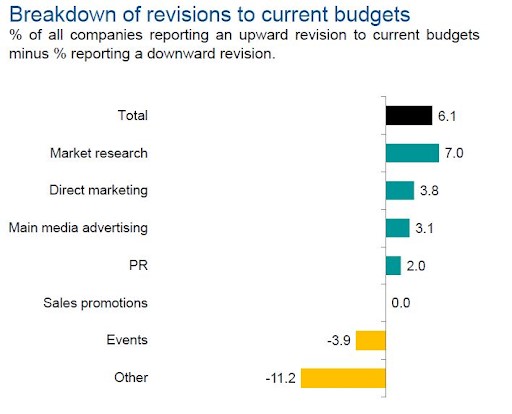Marketing budgets still growing, but more slowly: Bellwether | WARC | The Feed
The Feed
Read daily effectiveness insights and the latest marketing news, curated by WARC’s editors.
You didn’t return any results. Please clear your filters.

Marketing budgets still growing, but more slowly: Bellwether
UK companies continued to revise their total marketing budgets upwards in the fourth quarter of 2021 – a third successive quarter of expansion – but data from the IPA Bellwether Report shows the rate of growth halved from Q3, under the pressures of the Omicron strain of COVID-19, supply-chain disruption and inflation.
Headline Q4 figures
- A net balance of +6.1% of companies upwardly revised their total marketing budgets in Q4 (Q3 +12.8%).
- Market research (+7.0%) was the top performing category as businesses seek to better understand the impact the pandemic has had on existing clients and target audiences.
- Direct marketing (+3.8%) and main media advertising (+3.1%) also showed growth.
- Within main media, video (+7.3%), other online advertising (+4.5%) and PR (+2.0%) all grew but there were budget cuts in published brands (-5.9%), audio (-6.3%) and out of home (-8.3%); sales promotions budgets (0.0%) stagnated.
- Events (-3.9%) and other (-11.2%) marketing budgets registered cuts.
The year ahead
- A net balance of +34.5% of surveyed companies are planning to expand their total marketing spend in the coming 2022/23 financial year.
- Close to half (45.7%) of panellists were optimistic of budget growth, compared to just 11.2% expecting spending cuts.
- Events (+19.0% ) and sales promotions budgets (+17.9%) are expected to bounce back in the coming financial year.
- All other marketing activities also expect to see spending increase: main media marketing (+17.4%), direct marketing (+15.5%), other (+10.6%), PR (+9.6%) and market research (+7.4%).
- Bellwether’s annual adspend growth forecast is lowered from 6.2% to 5.2%.
Reaction
“The opportunities [Bellwether] panellists highlight point to the post-pandemic bounce back, further development of the digital behaviours that have been embraced through the pandemic, and the increasing acceleration of interest in the green economy. These are all areas for CMOs and planners to reflect on how they can embrace these topics and bring them into their marketing” – Rik Moore, Head of Insight Strategy and Planning at The Kite Factory.
“Brands clearly see opportunities, but they also know there is a real battle to capture spend as they navigate a potent mix of changing consumer behaviour and rising inflation putting pressure on household budgets. It’s absolutely crucial to understand people’s new essentials and what they’re willing to carve out disposable income for in this time of flux” – Louise Ainsworth, CEO EMEA at Kantar’s Media division.
Sourced from IPA Bellwether Report
Email this content
